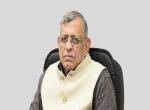Little interest has been shown domestically about possible new orientations in foreign policy under a Narendra Modi-led NDA government. Modi’s single-minded focus on the development agenda has dominated political and media discourse, barring, of course, the 2002 post-Godhra Gujarat violence. The slowdown of the economy, the negative investor sentiment, price rise, corruption, the perceived lack of leadership have been issues of public concern, not foreign policy.
For our foreign partners who see India’s economic rise as opening up enormous prospects for their own economies by way of trade and investment and who are disappointed by India’s lacklustre economic performance under UPA 2 because of slowdown of reforms, indecision and delays in implementation, Modi’s economic agenda is alluring. But they are equally interested in assessing the possible differences in foreign policy between a possible Modi-led government and the UPA governments.
Modi has been a state leader, with no stint in Delhi, and hence a relatively unknown entity for foreign interlocutors except those who have travelled to Gujarat for business reasons. Moreover, because he has been politically boycotted by western countries until recently for human rights reasons, the opportunities to assess him through personal contact have been that much less. China and Japan, who have received him in their countries, have been wiser in this regard.
Modi has not been grilled on foreign policy issues either by the opposition or the media. He has made some stray remarks on foreign affairs, but they should be seen more as obiter dicta rather than a considered judgment. His view, for instance, that the Ministry of External Affairs should focus on “trade treaties” rather than strategic issues may fit in with his “development” focus, but would get revised when faced with the reality of India’s challenges once in power at the Centre. If his meaning was that our missions should give priority attention to commercial/economic work, that would be unexceptionable in the context of economic performance increasingly determining a country’s international role and influence.
The economic argument should not be exaggerated though, as our most severe external challenges are driven not by economics but politics, relating to our territorial integrity, the threats to us from terrorism and religious extremism, the nuclear dangers emanating from nuclear collaboration between China and Pakistan which the West tolerates despite readiness to take military action to stop proliferation in Pakistan’s neighbourhood, and China’s attempts to politically and strategically box us in the sub-continent while simultaneously eroding our influence there by its deep incursions into our neighbourhood. If China and Pakistan have been hostile to us for decades it is not on account of economic issues. India’s role in the Indian Ocean has a major strategic aspect that goes beyond ensuring the safety of the sea lanes of communication for trade flows.
How much the foreign policy of the then Prime Minister Atal Bihari Vajpayee, who enjoys an iconic status within and even without the BJP, will guide that of an hypothetical Modi-led government is a pertinent question. If Vajpayee’s decision to take a plunge on the nuclear question was an act of strategic defiance, he was also a man of dialogue who made major overtures to US, China and Pakistan. With a strong nuclear card in his hand, his strategy of building a relationship with the US “as a natural ally” made sense, as did his outreach to China to explore the possibility of resolving the border issue on a political basis. His conciliatory approach towards Pakistan, however, seemed based less on a cold power calculus and more on inchoate hopes and sentimentalism.
Prime Minister Manmohan Singh built on Vajpayee’s policy on all these fronts, pointing to the essential continuity of our foreign policy under governments of different political complexions. The Next Steps in the Strategic Partnership under Vajpayee led to the nuclear deal under Manmohan Singh; the Special Representatives mechanism with China set up under Vajpayee has been the principal platform for political engagement with China on the vexed border issue under his successor; the obsession to have a dialogue with Pakistan under Vajpayee continued its confusing course after him. Is there a major course correction in foreign policy that a Modi-led NDA government would need to make?
Not really, as our geo-political compulsions, our economic needs and our security calculus dictate our fundamental foreign policy choices, with limited wiggle room available. We need a stable relationship with all power centres. Despite the difficulties of dealing with the US, our economic and people to people links with it are of key importance. The US has treated Modi with gross political ineptitude, giving him, if he becomes Prime Minister, room to extract a price for engaging him, though it is clear that his relationship with Obama will be uncomfortable. China’s Xi Jinping has already indicated his desire to visit India later this year. In visiting the Arunachal border with Tibet and vowing not to yield an inch of Indian territory, Modi has sent an important signal to Beijing. A visit to Tawang before Xi’s visit would change our psychological equation with China by boosting national morale.
Towards Pakistan, one hopes, Modi will not be counselled to adopt a soft face in order to attenuate his anti-Muslim image, both at home and abroad. Pakistan will construe this as the “taming” of Modi without cost. Because uncertainties in Afghanistan and religious radicalisation sweeping Pakistan could aggravate India’s terrorism problem, the new government should be in no hurry to resume the dialogue with Pakistan even if the bait of MFN is offered as a tactical move.
Whether or not a Modi-led government changes the course of our foreign policy, the very perception of him being a strong and decisive leader will be a foreign policy force-multiplier in itself.
Published Date: 28th March 2014, Image source: http://economictimes.indiatimes.com









Post new comment